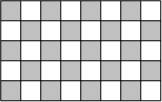

Case 2: One even and one odd.Suppose, for example, that {$a$} is odd and {$b$} is even (a similar argument works for {$a$} even and {$b$} odd).  Then there is no corner on the bottom that the path can reach traveling SW-NE. If {$c$} is even, the path will travel on white squares on top. The only corner possible is the SE corner, {$101$}, as predicted by the theorem ({$c-a$} is even, {$c-b$} is odd). If {$c$} is odd, the path will travel on gray squares on top and can only end at the NW corner, {$011$}, and again agreeing with the theorem. |